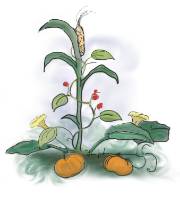Summary
Students will use an example problem about the Three Sisters to complete a Strategy Harvest and develop a conceptual understanding of multiplying.
Essential Question(s)
How can you use multiplication to solve problems?
Snapshot
Engage
Students encounter a story problem involving the Three Sisters and consider different ways to solve it.
Explore
Students complete a Strategy Harvest to find multiple multiplication strategies.
Explain
Students discuss various multiplications strategies and work out a new problem using various methods, as a whole class.
Extend
Students use a Chalk Talk strategy to apply uses of multiplication to various topics of interest and create their own problem.
Evaluate
Students are evaluated on their work in the Extend or optionally complete an Exit Ticket solving a new problem.
Materials
Strategy Harvest handout (optional, attached)
Exit Ticket handout (optional, attached)
Counters, such as seeds
Large paper, such as butcher or chart paper, or large sticky notes.
Notebook paper
Engage
Introduce the following problem to students: A Native American farming tradition is to plant the "Three Sisters" (beans, corn, and squash) together. These plants work together to help each other survive. If I have 8 sets of the 3 seeds, how many total seeds will I plant5?"
Give students a minute to start thinking about the different ways they can solve this problem.
Explore
Guide students in completing a Strategy Harvest. Begin by incorporating an Elbow Partner strategy. Give pairs of students a large piece of paper to solve the problem in any way that they choose. This should take about 5–10 minutes. Encourage students to begin by drawing a picture of the problem.
Students can use the attached Strategy Harvest handout to help track the different strategies.
Once students have worked out the problem, have them partner with another set of partners (to form a group of four) and explain their work to within to the other pair.
Give students a few minutes to return to their work and add to it or revise their thinking based on their discussion with the other partners.
Explain
Bring the class together as a whole and STRATEGICALLY (see guidelines below) ask students to share how they solved the problem.
The order should look something like this:
Students who drew a picture.
Students who used repeated addition. If one group says, "I added 8, 3 times," ask if anyone did it differently, such as adding 3, 8 times. Did they get the same answer?
Students who counted by 3’s. Did anyone count by 8s?
Students who drew an array. Could you do this instead of actual donuts?
Students who multiplied.
Independently, have students solve the following new problem by choosing one or two of the strategies the class has discussed:
Gardeners often use marigold plants to help keep weeds out of their garden, similar to how the Three Sisters help each other survive. Jaden has 4 marigold plants. Each plant has 5 flowers on it. How many flowers are there altogether?
As a class, work out this problem in repeated addition, array, and multiplication.
Allow students time to revise their work if necessary.
Extend
Using the Chalk Talk strategy, post four or five large sticky notes (or another type of paper) around the room. Write a topic heading on each piece of paper, such as cooking, gardening, playing video games, or other things your students are interested in. Have students write down a sentence that explains how they would use multiplication in that topic area.
Independently, have students use the Create the Problem strategy to imagine a story problem in one of the topic areas that would involve the following situation:
3 groups of 7 equal 21.
Have students share their problem with a partner. Then, have a few students share their partner's problem and explain why they thought it was a good problem.
Evaluate
Options A: Use the written problem and work to determine students understanding of multiplication.
Option B: Use an Exit Ticket. Distribute the attached Exit Ticket handout. Have the students answer the following question on a notecard, sticky note, or half sheet of paper:
"I have 4 bags of donut holes. Each bag has 6 donuts. How many donuts are there altogether?"
Resources
K20 Center. (n.d.). Bell ringers and exit tickets. Strategies. https://learn.k20center.ou.edu/strategy/125
K20 Center. (n.d.). Chalk talk. Strategies. https://learn.k20center.ou.edu/strategy/197
K20 Center. (n.d.). Create the problem. Strategies. https://learn.k20center.ou.edu/strategy/149
K20 Center. (n.d.). Elbow partners. Strategies. https://learn.k20center.ou.edu/strategy/116
K20 Center. (n.d.). Strategy harvest. Strategies. https://learn.k20center.ou.edu/strategy/135



